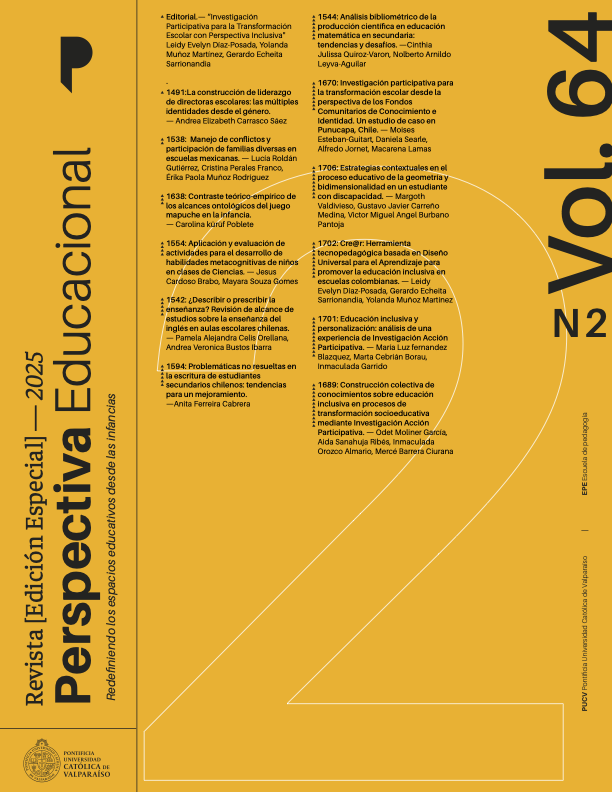Contextual Strategies in the Educational Process of Geometry and Two-Dimensionality in a Student with Disabilities
DOI:
https://doi.org/10.4151/07189729-Vol.64-Iss.2-Art.1706Keywords:
Intellectual disability vision reasoning geometry Van Hiele modelAbstract
The teaching and learning process for students with some type of disability is complex. Firstly, the isolation and exclusion of these students by their peers in different activities planned by the teacher is evident. Secondly, teachers plan activities for their participation but the intellectual and cognitive differences between students are framed. This situation sometimes has repercussions at a psychological level, causing demotivation and frustration when learning. This research involves the educational process aimed at developing geometric thinking under the Van Hiele model in a 12 years old student with visual and intellectual disabilities who is expected to attend the sixth grade at a Colombian public educational institution, implementing a case study.
The activities were planned to involve all students; however, learning delays and exclusion from peers were evident. Therefore, the teaching process requires a careful and adaptive approach to ensure learning opportunities. The prognosis showed that the participant was at Van Hiele level 1; thus, an open-field didactic sequence was implemented, advancing to level 2. Although there are constitutional and legal regulations on inclusion, there is often a gap between what is written on paper and the real-life experiences of the student, teacher, institution, and family, who face this social reality, highlighting the need for teacher training.
The research work was framed within a qualitative approach as it was a case study that not only addressed cognitive aspects related to geometry, but also addressed the social aspects related to the student. This research presents an in-depth analysis of the object of study, which has been analyzed with rigor in mind. Data collection is carried out in a way that demonstrates their veracity, fulfilling the criterion of contributing to the advancement of knowledge that can shed light on other research on the issues raised here. The methodology included three phases: diagnosis, implementation of learning activities, and reflection.
The results reflected that: i) the didactic strategies used have made it possible to bring the educational process closer by applying geometry to the specific conditions of a student under study and, in turn, has involved his peers in the educational process without truncating or relegating the progress of the rest of the group to which the student belongs, ii) with the intervention process implemented, the student managed to move from level 1 to level 2 in the Van Hiele model, that is, he moved from an informative level to one of understanding the relationships between the properties of geometric figures and how these are part of a whole, iii) significant progress was achieved in the level of development of the student's geometric knowledge, increasing his resilience and confidence to interact with geometric objects in his context, and iv) the study allowed us to recognize that inclusion is not just about policies and standards that must be applied in educational contexts, but rather it is an entire process of transition towards a society that is much more comprehensive and open to new forms of understanding, interaction and construction of knowledge with the human beings.
References
Artiles, A. J., & Trent, J. M. (2004). Inclusive education: Teaching and learning in diverse classrooms. Merrill Prentice Hall.
Cabrera, J. M., Cale, J. P., & Cabrera, E. L. (2019). La inclusión en el aula en escuelas con alto rendimiento escolar: Estudio de caso en escuelas de la provincia de Carchi, Ecuador. Revista Espacios, 40(44), 3.
Castro, M., & Muñoz, P. (2021). La exclusión social de los estudiantes con discapacidad en el contexto educativo chileno: Un análisis desde la perspectiva de los profesores. Revista de Educación Inclusiva, 15(1), 73-88.
Cobeñas, P. (2021). La mirada sobre la enseñanza de la Matemática a alumnos con discapacidad desde la producción curricular bonaerense: Un análisis desde la Educación Inclusiva (Trabajo final integrador, Universidad Nacional de La Plata). Repositorio institucional FaHCE-UNLP. https://www.memoria.fahce.unlp.edu.ar/tesis/te.1962/te.1962.pdf
Cobeñas, P., Grimaldi, V., Broitman, C., Sancha, I., & Escobar, M. (Coords.). (2021). La enseñanza de las matemáticas a alumnos con discapacidad (1.a ed). EDULP. https://sedici.unlp.edu.ar/bitstream/handle/10915/115580/Documento_completo.pdf?sequence=1
Delgado, K., Barrionuevo, L., & Essomba, M. A. (2021). La educación inclusiva en el nivel inicial. Estudio de caso. Revista Espacios, 42(3), Art. 3. https://doi.org/10.48082/espacios-a21v42v03p03
Díaz Barriga, Á. (2013). Guía para la elaboración de una secuencia didáctica. Comunidad de Conocimiento UNAM, 10(04), 1-15.
Dorantes, A. E. U., & Ojeda, J. I. M. (2023). Estrategias de Enseñanza Inclusiva de las Matemáticas en Educación Básica: Revisión Sistemática. Revista Digital: Matemática, Educación e Internet, 23(1), 1-20. https://doi.org/10.18845/rdmei.v23i1.6179
Escobar Guerra, L. M. (2021). Educación inclusiva: Una oportunidad para la transformación de la escuela rural [Tesis de doctorado, Universidad Metropolitana de Educación Ciencia y Tecnología]. Repositorio UMECiT. https://repositorio.umecit.edu.pa/handle/001/5395
Escobar, M. P., Muñoz, D. C., Piñones, C. D., & Cuadra, D. J. (2020). Tiempo escolar e inclusión educativa: un estudio de teorías subjetivas de profesores. Información Tecnológica, 31(5), 139-152. https://doi.org/10.4067/S0718-07642020000500139
Fondo de las Naciones Unidas para la Infancia. (2022). Estrategias de enseñanza aprendizaje para la inclusión educativa de todos y todas con énfasis en discapacidad intelectual. Gobierno de la República Dominicana. https://www.unicef.org/dominicanrepublic/media/7976/file/Estrategias%20de%20Ensenanza%20%7C%20enfasis%20en%20Discapacidad%20Intelectual%20-%20PUBLICACION.pdf
Fuentes Gómez, J. L. (2019). Fortalecimiento de pensamiento métrico-espacial en estudiantes con necesidades educativas de aprendizaje a través de una propuesta pedagógica para la enseñanza de la geometría [Conferencia]. Congreso Internacional de Investigación y Pedagogía, Universidad Pedagógica y Tecnológica de Colombia. Del 7 al 11 de octubre de 2019.
https://repositorio.uptc.edu.co/items/0de4bc2d-d656-49f8-ba23-5b17d9a86a1c
González Cardona, L. Y., Palacios Vargas, M. A., & Taborda Gil, V. (2020). Estrategias Metodológicas Implementadas en los Procesos Pedagógicos de Enseñanza-Aprendizaje con Estudiantes que tienen Discapacidad Cognitiva [Tesis de maestría, Institución Universitaria Tecnológico de Antioquia]. Repositorio institucional. https://repositorio.tdea.edu.co/bitstream/handle/tdea/1381/Informe%20%20Cualificaci%C3%B3n%20docente.pdf?sequence=1&isAllowed=y
Gutiérrez Reyes, S. C. (2025). Formación de profesores en atención a la diversidad: Enseñanza y aprendizaje de la geometría en estudiantes con discapacidad visual [Tesis de maestría, Universidad Autónoma de Bucaramanga]. Repositorio institucional. https://repository.unab.edu.co/bitstream/handle/20.500.12749/28465/2.Trabajo%20de%20grado_Slendy_Gutierrez.pdf?sequence=1&isAllowed=y
Krasimirova, I., & Gil, M. E. (2022). Matemáticas recreativas. Un taller geométrico para jóvenes con discapacidad intelectual [Tesis de magisterio, Universidad Zaragoza]. Repositorio institucional. https://zaguan.unizar.es/record/120703/files/TAZ-TFG-2022-1978.pdf
Lasso, M. A. (2022). Desarrollo del pensamiento espacial en niños con déficit cognitivo. [Trabajo de grado, Universidad del Valle]. Repositorio institucional. https://bibliotecadigital.univalle.edu.co/server/api/core/bitstreams/964b1f15-2ae4-4344-b5b7-8228bba47fa1/content
Lobo, N. (2004). Aplicación del modelo propuesto en la Teoría de Van Hiele para la enseñanza de la geometría. Multiciencias, 4(1), Art. 4.
Marulanda, E., & Aldana, J. C. (2024). Prácticas pedagógicas, conocimientos y condiciones institucionales en las que laboran docentes colombianos. Un estudio sobre educación inclusiva y discapacidad. Psicología desde el Caribe, 41(3), 53-79.
Ministerio de Educación Nacional. (2016). Derechos Básicos de Aprendizaje Matemáticas (DBA). http://aprende.colombiaaprende.edu.co/sites/default/files/naspublic/DBA_Matem%C3%A1ticas.pdf
Ochoa Cervantes, A. (2019). El tipo de participación que promueve la escuela, una limitante para la inclusión. Alteridad. Revista de Educación, 14(2), 184-194. https://doi.org/10.17163/alt.v14n2.2019.03
Osorno Monsalve, C. A. (2014). Propuesta integradora para el desarrollo del pensamiento geométrico en estudiantes con discapacidad intelectual [Tesis de maestría, Universidad Nacional de Colombia]. Repositorio institucional. https://repositorio.unal.edu.co/bitstream/handle/unal/75000/8160796.2014.pdf?sequence=1
Procel, X. Y. (2021). Modelo de Van Hiele y su utilización para la enseñanza de la geometría. Polo del Conocimiento: Revista científico-profesional, 6(3), 2261-2278.
Rodríguez, G., Gómez, M., & López, L. (2020). El aislamiento y la exclusión social en estudiantes con necesidades educativas especiales: Un análisis desde la perspectiva docente. Revista de Educación Inclusiva, 14(2), 123-140.
Sánchez Casas, L. M. (2024). Enseñanza de triángulos semejantes a personas con discapacidad visual en un curso orientado a docentes de matemáticas de la IE Ricaurte de Soacha [Tesis de maestría, Universidad Pedagógica Nacional]. Repositorio institucional. http://repository.pedagogica.edu.co/bitstream/handle/20.500.12209/20918/Ense%C3%B1anza%20de%20tri%C3%A1ngulos%20semejantes.pdf?sequence=1
Silva Ramos, S. B. (2016). Una secuencia didáctica para estudiantes con discapacidad cognitiva relacionada con el reconocimiento y la descripción de sólidos y figuras geométricas planas [Tesis de doctorado, Universidad Nacional de Colombia]. Repositorio institucional. https://repositorio.unal.edu.co/bitstream/handle/unal/59381/susanbellanydsilvaramos.2016.pdf?sequence=1
Tigrero Vaca, J. (2021). Inclusión, competencias docentes y participación estudiantil. Estudio de caso en un instituto tecnológico superior de Guayaquil-Ecuador [Tesis de doctorado, Universidad de Vigo].
Torres Ibarra, M., Gallego Guzmán, J. D., & Calvillo Guevara, N. J. (2024). Una alternativa para trabajar el pensamiento matemático a través de modelación en el nivel medio superior. El cálculo y su enseñanza, 20(2), 67-86. https://doi.org/10.61174/recacym.v20i2.225
Valdés, R., & Gómez-Hurtado, I. (2019). Competencias y prácticas de liderazgo escolar para la inclusión y la justicia social. Perspectiva Educacional, 58(2), 47-68. https://doi.org/10.4151/07189729-Vol.58-Iss.2-Art.915
Vargas, G., & Gamboa, R. (2013). El modelo de Van Hiele y la enseñanza de la geometría. Uniciencia, 27(1), 74-94.
Vásquez, C. (2019). Pensamiento Espacial mediado por el uso de TIC en estudiantes con Discapacidad Cognitiva Baja Ciclo I Colegio Nueva Colombia (IED) [Tesis de maestría, Universidad de la Sabana]. Repositorio institucional. https://intellectum.unisabana.edu.co/bitstream/handle/10818/38352/tesis%20Claudia%20V%C3%A1squez.pdf?sequence=5&isAllowed=y
Downloads
Published
How to Cite
Issue
Section
Categories
License
Copyright (c) 2025 Margoth Valdivieso

This work is licensed under a Creative Commons Attribution-ShareAlike 4.0 International License.
The authors grant an exclusive licence, without time limit, for the manuscript to be published in the Perspectiva Educacional journal, published by the Pontificia Universidad Católica of Valparaíso (Chile), through the School of Pedagogy.





